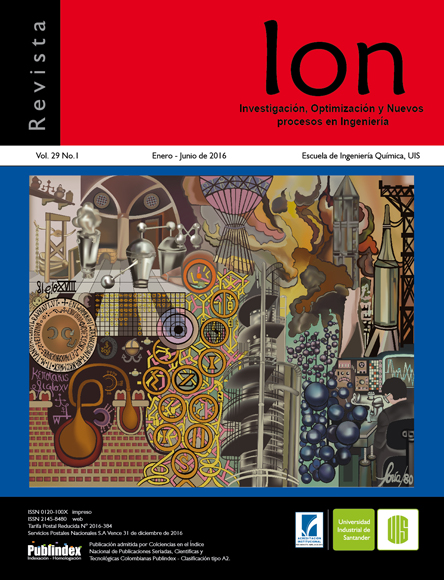Characterization of trophic groups throughout an anaerobic digestion process with cattle manure slurry using a low-cost method
Published 2016-07-15
Keywords
- Trophic Groups,
- Metabolic Groups,
- Kitchen Waste,
- Cattle Manure Slurry,
- MPN
- Microbial activities. ...More
How to Cite
Copyright (c) 2022 María Soledad Alzate Moncada, Mabel Quintero Silva

This work is licensed under a Creative Commons Attribution 4.0 International License.
Abstract
This study identified and quantified microbial populations in cattle manure slurry, responsible for anaerobic degradation of kitchen waste using activity tests and Most Probable Number for key trophic groups in the process. Hydrolytic, acidogenic, acetogenic, specific methanogenic acetoclastic and hydrogenotrophic activities were evaluated using as model substrates starch, glucose, propionate-butyrate mix, acetate and formate, respectively. Anaerobic digestion from kitchen waste was developed for 35 days in batch reactors of 50 mL containing an inoculums/substrate ratio of 3. Samples were taken from digesters every 7 days to evaluate microbial populations by counting metabolic groups. This study demonstrates that there is an association between biomass activity and population of trophic groups related. Additionally, CMS is an inoculum with high quality to start-up the anaerobic process with kitchen waste. On the other side, MA/FB ratio and MA/SRB ratio are important microbial parameters to evaluate performance of reactor. Finally, AD from kitchen waste reached a yield coefficient of 0.41m3 CH4/kgVS using cattle manure sludge as inoculum
Downloads
References
[2] Appels L, Baeyens J, Degreve J, Dewil R. Principles and potential of anaerobic digestion waste active sludge. PECS. 2008;34:755-81.
[3] Sanz J, Köchling T. Molecular biology techniques used in wastewater treatment: An overview. Process Biochem. 2007;42:119–33.
[4] Ito T, Yoshiguchi K, Ariesyady HD, Okabe S. Identification and quantification of key microbial trophic groups of methanogenic glucose degradation in an anaerobic digester sludge. Biores Technol. 2012;123;599–607.
[5] Regueiro L, Veiga P, Figueroa M, AlonsoGutierrez J, Stams A, Lema JM, Carballa M. Relationship between microbial activity and microbial community structure in six full-scale anaerobic digesters. MR. 2012;167;581–9.
[6] Rodríguez Miranda, Nelson. Estudio de factibilidad técnica y financiera de utilizar biomasa para suplir las necesidades energéticas en el edificio de Bienestar Universitario (Tesis de pregrado). Bucaramanga, Colombia: Universidad Industrial de Santander; 2010.
[7] Álvarez E, Calderón D. Modelamiento del rendimiento de metano de los residuos sobrantes de restaurante UIS (Tesis de pregrado). Bucaramanga, Colombia: Universidad Industrial de Santander; 2012.
[8] APHA-AWWA-WPCF. Standard Methods for Examination of Water and Wastewater - SMEWW. 21th Ed. Washington D.C., U.S.A; 2005.
[9] Angelidaki I, Alves M, Bolzonella D, Borzacconi L, Campos JL, Guwy A J, et al. Defining the biomethane potential (BMP) of solid organic wastes and energy crops: a proposed protocol for batch assays. WST. 2009;59(5):927-34.
[10]Sandoval C, Vergara M, Carreño M, Castillo E. Microbiologic characterization and specific methanogenic activity of anaerobe sludge used in urban solid waste treatment. WM. 2009;29:704–11.
[11] Angelidaki I, Sanders W. Assessment of the anaerobic biodegradability of macropollutants. RESB. 2004;3:117–29.
[12] Díaz-Báez M, Espitia S, Molina F. Digestión Anaerobia: Una aproximación a la tecnología. Colombia: Universidad Nacional de Colombia; 2002.
[13] Miller G. Use of dinitrosalicylic acid reagent for determination of reducing sugar. AChemistry. 1959;31:426–8.
[14] Anderson G, Yang G. Determination of bicarbonate and total volatile acid concentration in anaerobic digesters using a simple titration. WER. 1992;64:53–9.
[15]Quintero M, Castro L, Ortiz C, Guzmán C, Escalante H. Enhancement of starting up anaerobic digestion of lignocellulosic substrate: fique’s bagasse as an example. BT. 2012;108:8-13.
[16] Torres P, Pérez A, Cajigas A, Jurado C, Ortiz N. Selección de inóculos para el tratamiento anaerobio de aguas residuales del proceso de extracción de almidón de yuca. EIDENAR. 2007;6:105-11.
[17] Mussati M, Aguirre P, Scenna N. Modelado del proceso de digestión anaeróbica en reactores simples. En: Modelado, Simulación y Optimización de Procesos Químicos. Scenna NJ, Editor. Argentina: Editorial Universitaria de la UTN; 1999. p. 697-739.
[18] Cardinali-Rezende J, Pereira Z, Sanz J, Chartone-Souza E, Nascimento A. Bacterial and archaeal phylogenetic diversity associated with swine sludge from an anaerobic treatment lagoon. WJMBiotech. 2012;28:3187–95.
[19] Elferink S, Vorstman W, Sopjes A, Stams A. Characterization of the sulfate-reducing and syntrophic population in granular sludge from a full-scale anaerobic reactor treating paper mill wastewater. FEMS Microbiology Ecology. 1998;27:185-94.

